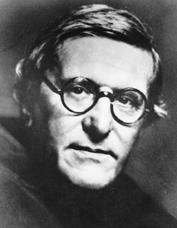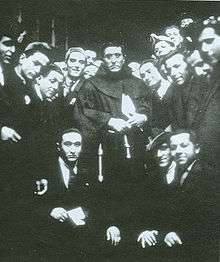Agostino Gemelli
| The Rev. Agostino Gemelli, O.F.M. | |
|---|---|
 | |
| Born |
18 January 1878 Milan, Kingdom of Italy |
| Died |
15 July 1959 (aged 81) Milan, Italy |
| Nationality | Italian |
| Fields | Medicine, Neuropsychology and Physiology |
| Institutions | Università Cattolica del Sacro Cuore |
| Known for | Founding the Catholic University of Milan; Neurophysiological research |
Agostino Gemelli, O.F.M., (18 January 1878 – 15 July 1959) was an Italian Franciscan friar, physician and psychologist, who was also the founder and first Rector of Università Cattolica del Sacro Cuore of Milan (Catholic University of the Sacred Heart).
Gemelli's Institute of Psychology was the most prominent institution of its kind in Italy. In 1921 he founded a teaching hospital for the Medical School of the University, located in Rome, the Agostino Gemelli University Polyclinic, which is now named after him. He focused some of his research on the psychology of the workplace.
Life
Early life
He was born Edoardo Gemelli in 1878 to a free-thinking upper class family in Milan, who were members of the Masonic movement. In his youth, his commitment to social causes led him to become a member of the Italian Socialist Party. He went to Ghislieri College for his education. After his training as a physician, he carried out neurophysiological and psychological experiments, some with the famed physiologist Camillo Golgi.
Gemelli, who had been an agnostic from his upbringing, had a religious conversion from his experience of military service in a hospital, that brought him into contact with a chaplain there who impressed him deeply. This led him to join the Order of Friars Minor in 1903, at which time he took the name Agostino. He was professed in the Order on 23 December 1904, and ordained on 14 March 1908. As members of religious Orders were barred by the Catholic Church from practicing medicine then, he continued his medical research, moving into the field of neuropsychology, where he was dissatisfied with many of the theories regarding the central nervous system held at the time.
Religious founder
At the same time, Gemelli undertook many spiritual activities, helping to found the secular institute of the Missionaries of the Kingship of Christ, established by the Venerable Armida Barelli, a Christian social activist. He first led her to join the Third Order of St. Francis, and in 1919, seeking a greater commitment, under his guidance, Barelli joined with other Franciscan tertiaries to form this group. In 1928, he guided the establishment of a men's branch of the Institute, led by the Servant of God, Giorgio La Pira, who was a member of the Italian Senate.
Università Cattolica del Sacro Cuore

Gemelli founded the Catholic University in 1921, and soon gained the patronage of Pope Benedict XV. It was founded as an instrument of forming a new leadership class for a future Catholic state. This religiously motivated political goal was intended to counteract the anti-clerical state established by the unifiers of modern Italy in 1860.[1]
In 1929 the Holy See signed a Concordat with the government of Benito Mussolini, which made the Catholic Church the state religion of Italy. At that point, the university became a laboratory for Catholic social policies through which the church might bring the Fascist state in line with canon law and papal teachings.[2] Gemelli taught as a Professor of Applied Psychology at the university.
Despite Gemelli’s accommodations to the state, he maintained relative autonomy for his university. This allowed the left-wing of the Christian Democratic Party to organize and develop at the Università Cattolica during Mussolini’s peak years.[2]
There is a long lasting discussion about Gemellis supposed antisemitism: one the one hand, he wrote a viciously antisemitic article about the intellectual Felice Momigliano in 1924. His alleged support of the Fascist regime's racial laws in 1938, which were aimed primarily at Jews, is controversial.[3] On the other hand, he helped many Jews, especially several scientists (among others, Tullio Levi-Civita and Vito Volterra).
Academic honors
Gemelli is also considered one of the 20th century's most prominent Franciscans. He worked to reconcile Christian faith and modern culture, though questions have arisen about his political legacy in recent times.[4]
Despite his many administrative duties as University Rector (which he performed until his death), Gemelli's endeavors involved both scientific and philosophical studies. At the request of Pope Pius XI, he also served as the first President of the Pontifical Academy of Sciences (1937). In addition, he wrote extensively on the contemporary meaning of Franciscan spirituality and was a pioneer in actively engaging the laity in the mission of the church.
Gemelli died in Milan on 15 July 1959.[5]
Padre Pio controversy
Agostino Gemelli was a harsh critic of the character of the Capuchin Saint Pio, stating that Padre Pio was "an ignorant and self-mutilating psychopath who exploited people's credulity" with his stigmata.[6] Gemelli's criticism is believed to have been instrumental in moving the Vatican to take various measures in censuring Padre Pio, including a prohibition on celebrating Mass in public.
Publications
- Rivista di filosofia neoscolastica (1908)
- La lotta contro Lourdes (1911), a book in which he took on the medical establishment of Milan regarding the scientific reliability of cures claimed at the Shrine of Our Lady of Lourdes in France, noted for the great number of healings taking place there
- Vita e Pensiero (1914)
- Biologie (1939)
- La psicotecnica applicata alle industrie (1944)
- La psicologia dell'orientamento professionale (1945)
- Psicologia dell'età evolutiva, with Agatha Sidlauskas (1946)
- La personalità del delinquente (1946)
- Introduzione alla psicologia, with Giorgio Zunini (1947)
- La criminologia e il diritto penale (1951)
- Archivi della Psicología, Neurología e Psichiatría
- Associazione Cattolica Internazionale degli Studi Medicali-Psicologici
References
- ↑ Hammond, J. Casey (January 1, 2010). "Padre Agostino Gemelli and the crusade to rechristianize Italy, 1878--1959". University of Pennsylvania Repository of Dissertations. Retrieved March 21, 2012
- 1 2 Hammond
- ↑ Lovatti, Maurilio. "La presunta adesione di padre Agostino Gemelli al Manifesto della Razza: un falso storico?" (in Italian). Retrieved February 18, 2015
- ↑ Massina, Dino (October 10, 2011). "La legenda nera di padre Gemelli, una interpretazione riduttiva". Corriere della Serra:I Blog (in Italian). Retrieved March 21, 2012
- ↑ HIMETOP
- ↑ "Vatican makes a saint of the man it silenced". The New Zealand Herald. 17 June 2002. Retrieved 15 September 2011.
- Falconi, Bruno (2007). "[A topical subject in the Lombardy of 1906: the regeneration of nerves]". Medicina nei secoli. 19 (2): 361–71. PMID 18450021.
- Colombo, Daria (2003). "Psychoanalysis and the Catholic Church in Italy: the role of Father Agostino Gemelli, 1925–1953". Journal of the history of the behavioral sciences. 39 (4): 333–48. doi:10.1002/jhbs.10153. PMID 14601040.
- Lomonaco, T (November 1978). "[Agostino Gemelli, one of the most important founders and promoters of aeronautical medicine in Italy]". Minerva Med. 69 (53): 3615–9. PMID 366463.
- Barraciu, A (April 1967). "[A worthy monument to Agostino Gemelli: the Policlinico Universitario della "Cattolica"]". Minerva Med. 58 (28 Suppl): 471–2. PMID 5337629.
- Medea, E (1966). "[Father Agostino Gemelli (1878–1959)]". Archivio di psicologia, neurologia e psichiatria. 27 (2): 98–105. PMID 5329205.
- PIUS XII, XII (1958). "[Homage to Father Gemelli.]". Rivista di medicina aeronautica. 21 (1): 201–3. PMID 13555581.
- BIZZARRINI, G (January 1951). "[The stigmata of St. Francis of Assisi seen by the Franciscan friar Agostino Gemelli; an eloquent lesson by the famous biologist, psychologist and psychiatrist.]". Minerva Med. 42 (1): Varia, 10–3. PMID 14826556.
| Wikimedia Commons has media related to Agostino Gemelli. |
| Wikisource has original works written by or about: Agostino Gemelli |
| Academic offices | ||
|---|---|---|
| Preceded by New position |
Rector of Università Cattolica del Sacro Cuore 7 December 1921 - 1959 |
Succeeded by Francesco Vito |